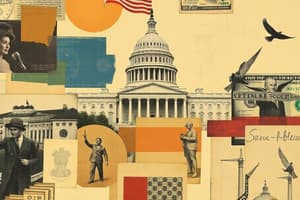Podcast
Questions and Answers
What is the primary objective of an expansionary fiscal policy?
What is the primary objective of an expansionary fiscal policy?
- To reduce government spending
- To increase the money supply to individuals (correct)
- To limit public projects
- To decrease taxation for high earners
What effect does increased government spending typically have on demand?
What effect does increased government spending typically have on demand?
- It creates higher demand (correct)
- It has no effect on demand
- It leads to a decrease in demand
- It stabilizes existing demand
How does increased taxation affect the economy according to the discussion?
How does increased taxation affect the economy according to the discussion?
- It generates more government revenue to stimulate demand (correct)
- It reduces overall economic activity
- It encourages businesses to spend less
- It reallocates money without increasing demand
What is the primary goal of contractionary fiscal policy?
What is the primary goal of contractionary fiscal policy?
Which statement best describes the relationship between government spending and public projects?
Which statement best describes the relationship between government spending and public projects?
What does the intersection of the Aggregate Demand (AD) and Aggregate Supply (AS) curves determine?
What does the intersection of the Aggregate Demand (AD) and Aggregate Supply (AS) curves determine?
Which of the following best defines Full Employment GDP?
Which of the following best defines Full Employment GDP?
How does a significant decline in Aggregate Demand (AD) typically affect the economy?
How does a significant decline in Aggregate Demand (AD) typically affect the economy?
What is the typical unemployment rate range in the US as stated in the notes?
What is the typical unemployment rate range in the US as stated in the notes?
Which economic factor is NOT typically influenced by monetary policies?
Which economic factor is NOT typically influenced by monetary policies?
What is the primary cause of cyclical unemployment?
What is the primary cause of cyclical unemployment?
According to Okun's Law, what is the impact of a 1% increase in the unemployment rate on GDP?
According to Okun's Law, what is the impact of a 1% increase in the unemployment rate on GDP?
What does the full employment rate of unemployment imply?
What does the full employment rate of unemployment imply?
What does potential GDP represent?
What does potential GDP represent?
What would be a direct result of a decrease in GDP as per Okun’s Law?
What would be a direct result of a decrease in GDP as per Okun’s Law?
Flashcards
Increased Government Spending
Increased Government Spending
Higher government spending creates more demand as resources are used for public projects, boosting the economy.
Increased Taxes
Increased Taxes
More taxes bring more money into the government's hands, potentially boosting demand as the government then spends more.
Expansionary Policy
Expansionary Policy
Fiscal policy that aims to put more money in people's hands to increase demand and economic activity.
Contractionary Policy
Contractionary Policy
Signup and view all the flashcards
Fiscal Policy
Fiscal Policy
Signup and view all the flashcards
Aggregate Demand
Aggregate Demand
Signup and view all the flashcards
Aggregate Supply
Aggregate Supply
Signup and view all the flashcards
Equilibrium
Equilibrium
Signup and view all the flashcards
Recession
Recession
Signup and view all the flashcards
Inflation
Inflation
Signup and view all the flashcards
Cyclical Unemployment
Cyclical Unemployment
Signup and view all the flashcards
Full Employment Rate
Full Employment Rate
Signup and view all the flashcards
Okun's Law
Okun's Law
Signup and view all the flashcards
What does Okun's Law measure?
What does Okun's Law measure?
Signup and view all the flashcards
What is the typical Okun's Law factor?
What is the typical Okun's Law factor?
Signup and view all the flashcards
Study Notes
Fiscal Policy
- Fiscal policy involves government spending and taxation
- Increasing government spending leads to increased demand
- Increased taxes reduce demand
- Expansionary fiscal policy increases everyone's money
- Contractionary fiscal policy reduces the amount of money people have
Studying That Suits You
Use AI to generate personalized quizzes and flashcards to suit your learning preferences.




